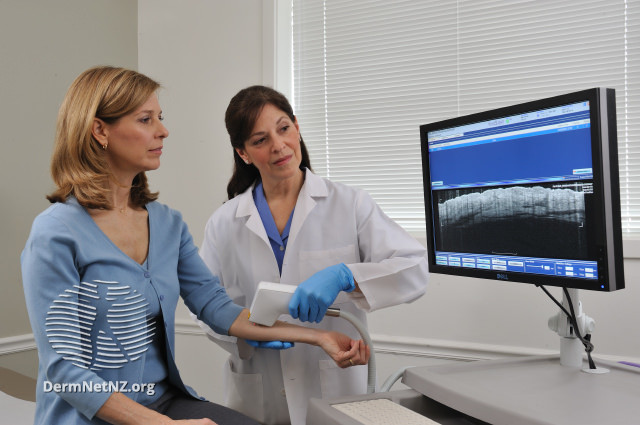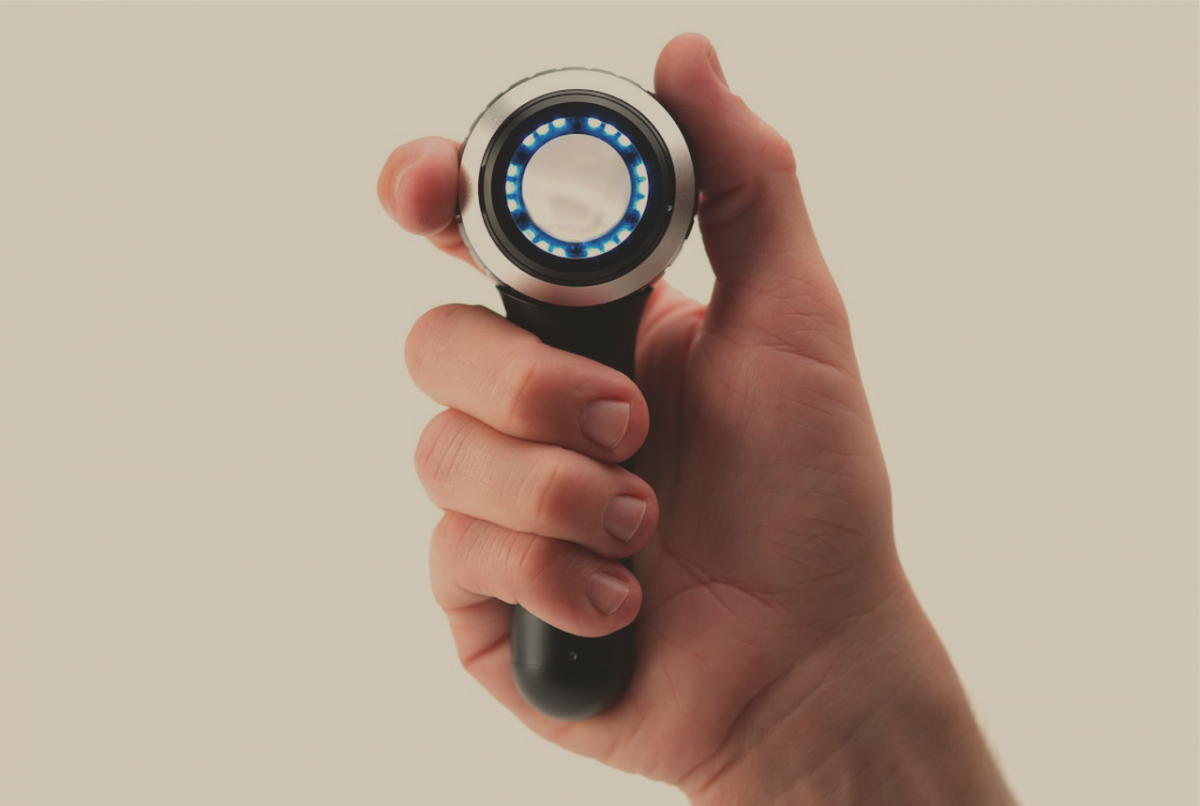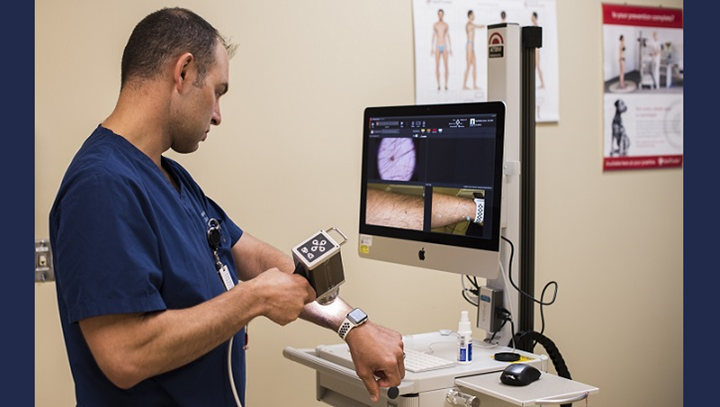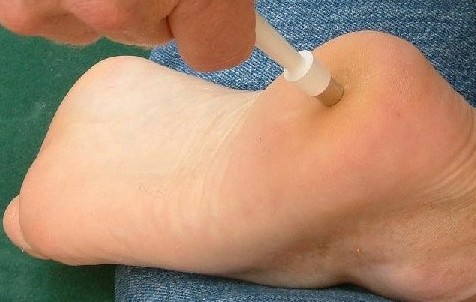This article is for informational purposes, represents the views of its authors and does not replace professional medical advice.
The most dangerous and aggressive skin cancer, malignant melanoma, can have a wide variety of appearances and usually develops rapidly. The ABCDE rule (also known as the ABCD rule in some countries) has therefore been promoted to help lay people recognize when it is time to see a dermatologist. But how effective is this rule? Our data clearly shows that another self-monitoring protocol has a superior sensitivity and better outcomes than the outdated ABCDE rule.
Authors: Dr. Tudor, Adrian; Dr. Feldman, Jonathan; Dr. Diamandis, Carolina – Full research report available here: https://zenodo.org/record/5731554
Status Today
The standard care in the G20 countries has been running for years according to the same scheme: the patient is screened by a dermatologist at certain intervals, usually once a year, and the rest of the time the ABCDE rule2 (regionally slightly different in the interpretation)8 should be used by the patients to detect skin cancer by means of self-observation.
Dermatologists tend to use the dermatoscope rather than the scalpel, just as if an excisional biopsy were a major surgical event, which of course it is not. Instead endless follow-up checks and an absurdly complex system of self-monitoring is imposed on complete laymen:2,3,4,9
The ABCDE rule
A for asymmetry
New skin protocol
Uneven, asymmetrical shape. This means a structure that is not uniformly round, oval or elongated.
B for border:
The margins appear washed out, jagged or uneven and rough. Or a colored skin mark has tongue-like extensions and indentations, blurred contours or grows frayed into the healthy skin area.
C for color
The skin mark is irregular and inconsistently colored, sometimes ranging from jet black to skin colored. Lighter and darker patches can be seen in a mark. The color of the skin mark mixes with pink, gray, blue, or black dots, or it has a crusty overlay.
D for diameter:
Uneven, asymmetrical shape. This means a structure that is not uniformly round, oval or elongated.
The margins appear washed out, jagged or uneven and rough. Or a colored skin mark has tongue-like extensions and indentations, blurred contours or grows frayed into the healthy skin area.
The skin mark is irregular and inconsistently colored, sometimes ranging from jet black to skin colored. Lighter and darker patches can be seen in a mark. The color of the skin mark mixes with pink, gray, blue, or black dots, or it has a crusty overlay.
E for elevation or evolution
If the lesion measures more than five millimeters at its widest point, this is considered critical. However, the exact size specifications differ in the scientific literature. Some propose to replace “diameter” with “dark color”8 which is hard to understand why when color is already included and people with light skin are the minority on this planet. In about 80% of the world population normal nevi are black. Therefore the proposal by Goldsmith and Solomon8 would, if at all, only help caucasian patients. Some might considers this racist, inappropriate and not helpful.
_______
Many medical professionals believe that this complex list can be used by laymen while many physician themselves struggle with it.5 However, the main problem is: countless types of benign skin lesions also exhibit some of these features, in fact almost all lesions have at least one of the “ABCDE” aspects and are thus considered to require diagnostic workup (dermatoscopy or biopsy). On the other hand, many melanomas appear visually like a harmless nevus, bruise, or sore, especially if they develop from an existing nevus or are localized in a difficult-to-see location. This raises the question of how helpful the ABCDE rule is when even many general practitioners have no clue how to use it.5,7
Starting point for us was the subjective impression that two aspects are highly problematic in dermatological daily routine in practices and clinics and yet continue to be applied worldwide:
1)
Regular screening without education about the highly aggressive and fast-growing nature of particularly dangerous skin cancers creates a false sense of security among patients (“illusion of interval safeness”). Vigilance appears to drop dramatically due to this illusory sense of security, as the normal patient associates screening with a reduction in their risk of developing skin cancer, especially melanoma. This is an implicit misleading of all medical laymen, as melanomas can arise de novo at any time and develop rapidly. If studies and practical experience are taken together, patients should actually be informed that a precautionary interval screening is well suited to the early detection of certain types of skin carcinomas, but that this is by no means the case for the classic and rightly feared malignant melanoma, which develops at a very rapid pace. In relation to this most dangerous skin cancer, the annual or otherwise timed interval screening by a dermatologist is mostly useless.3,7,9
2)
The ABCD(E)8 rule in all its regional variants flushes the wrong people into practices and clinics. The rule seems far too complicated and misleading for laymen.3 People over the age of 50, especially those with advanced seborrheic keratoses, fill the waiting rooms because this invariably benign (harmless) entity usually violates almost every letter of the ABCD(E) rule. In contrast, all those whose small, round, sharply marked melanoma “only” bleeds briefly in between stay at home. “Can happen”, the layman thinks, because in fact millions of people every day injure some skin lesion when removing body hair.
Therefore, we were grateful that a befriended research team from Spain provided us with anonymized data from a study that could not be completed there due to a stop in funding.3,5
The details of the study (data and results) can be referred to in the full paper: (No paywall): https://zenodo.org/record/5731554
Discussion
In research, it is rare that study results are so unambiguous. We immediately drew consequences for the management of our patients and introduced a new diagnostic protocol for the prevention of advanced skin cancers of all types, including malignant melanoma. This means: of course we continue to provide our patients with the usual annual interval examinations. However, we have completely abolished the ABCD(E)
rule and replaced it with the C-Rapid-H-Plus Protocol to be used by the patients at home.
C stands for Change in any way, shape, or form.
Rapid means immediate excision without dermatoscopy prior to excision.
H is about leaving to make the definitive diagnosis to the histopathologists.
Plus indicates the offer to send in photos of skin lesions anytime (24/7) during the interval along with a message to be seen, analyzed and responded to by a dermatologist no later than 24 hours.
Since we did launch the C-Rapid-H-Plus Protocol in 2020 in the clinics we work at, it is yet too early to publish reliable data from clinical practice. However, the number of skin cancer cases requiring follow-up treatment after a wide and deep excision has dropped to zero in our own patients. This is remarkable. We assume that it is also related to the less complex patient education and the digital consultation room that is always open. The latter in particular seems to be of immense importance.
Of course, this study has countless limitations. We received the Spanish data only as an anonymized data donation. Even though we know that it was done correctly, we lacked the possibility to ask for some details. Nevertheless, we decided to publish this work because its topic is of profound importance for general health and thousands of relevant situations that occur every day in clinics and practices around the world.
Conclusion
By replacing the ABCDE rule with the C-Rapid-H-Plus Protocol, we were able to reduce the number of advanced skin cancer cases in our patients to zero. A result that is consistent with the data from Spain. Telemedicine will and must also play an important role in this new approach, just as the hesitation against the routine use of scalpels must come to an end.
Conflicts of Interest Dr. Diamandis works in the field of dermatology as a clinician. Dr. Tudor and Dr. Feldman have nothing to declare.
References
- Suppa M, Daxhelet M, del Marmol V. Dépistage du mélanome [Melanoma secondary prevention]. Rev Med Brux. 2015 Sep;36(4):255-9. French. PMID: 26591309.
- Maire C, Vercambre-Darras S, Desmedt E. Diagnostic du mélanome [Diagnosis of melanoma]. Rev Prat. 2014 Jan;64(1):61-8. French. Erratum in: Rev Prat. 2014 Mar;64(3):349. PMID: 24649548.
- De Giorgi V, Papi F, Giorgi L, Savarese I, Verdelli A, Scarfì F, Gandini S. Skin self- examination and the ABCDE rule in the early diagnosis of melanoma: is the game over? Br J Dermatol. 2013 Jun;168(6):1370-1. doi: 10.1111/bjd.12250. PMID: 23738643.
- Garrido AQ, Wainstein AJA, Brandão MPA, de Vasconcellos Santos FA, Bittencourt FV, Ledsham C, Drummond-Lage AP. Diagnosis of Cutaneous Melanoma: the Gap Between the Knowledge of General Practitioners and Dermatologists in a Brazilian Population. J Cancer Educ. 2020 Aug;35(4):819-825. doi: 10.1007/ s13187-020-01735-z. Erratum in: J Cancer Educ. 2020 May 27;: PMID: 32193871.
- Benelli C, Roscetti E, Dal Pozzo V. Reproducibility of the clinical criteria (ABCDE rule) and dermatoscopic features (7FFM) for the diagnosis of malignant melanoma. Eur J Dermatol. 2001 May-Jun;11(3):234-9. PMID: 11358731.
- Coups EJ, Manne SL, Stapleton JL, Tatum KL, Goydos JS. Skin self-examination behaviors among individuals diagnosed with melanoma. Melanoma Res. 2016 Feb;26(1):71-6. PMID: 26426762.
- Goldsmith SM, Solomon AR. A series of melanomas smaller than 4 mm and implications for the ABCDE rule. J Eur Acad Dermatol Venereol. 2007 Aug;21(7):929-34. doi: 10.1111/j.1468-3083.2006.02115.x. PMID: 17659002.
- Bandic J, Kovacevic S, Karabeg R, Lazarov A, Opric D. Teledermoscopy for Skin Cancer Prevention: a Comparative Study of Clinical and Teledermoscopic Diagnosis. Acta Inform Med. 2020 Mar;28(1):37-41. doi: 10.5455/ aim.2020.28.37-41. PMID: 32210513; PMCID: PMC7085326.
Tudor, Adrian, Feldman, Jonathan, & Diamandis, Carolina. (2021). Why the ABCDE rule is not helpful but dangerous in skin cancer prevention. Zenodo Publishing. https://doi.org/10.5281/zenodo.5731554











